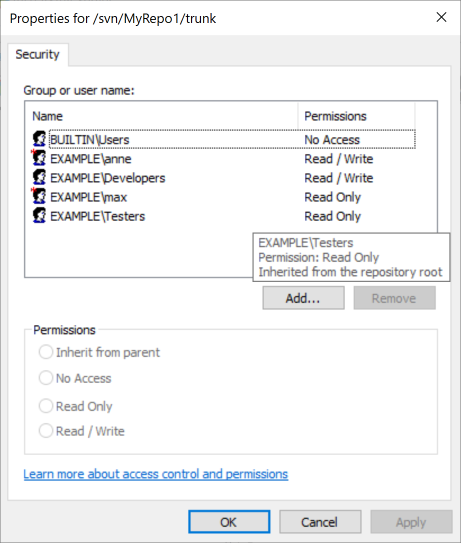I have set up a repository using SVN and uploaded projects. There are multiple users working on these projects. But, not everyone requires access to all projects. I want to set up user permissions for each project.
How can I achieve this?
I have set up a repository using SVN and uploaded projects. There are multiple users working on these projects. But, not everyone requires access to all projects. I want to set up user permissions for each project.
How can I achieve this?
In your svn\repos\YourRepo\conf folder you will find two files, authz and passwd. These are the two you need to adjust.
In the passwd file you need to add some usernames and passwords. I assume you have already done this since you have people using it:
[users]
User1=password1
User2=password2
Then you want to assign permissions accordingly with the authz file:
Create the conceptual groups you want, and add people to it:
[groups]
allaccess = user1
someaccess = user2
Then choose what access they have from both the permissions and project level.
So let's give our "all access" guys all access from the root:
[/]
@allaccess = rw
But only give our "some access" guys read-only access to some lower level project:
[/someproject]
@someaccess = r
You will also find some simple documentation in the authz and passwd files.
@groupname this one bit me when defining rules, it's perfect in your examples, just pointing out. –
Isisiskenderun @Stephen Bailey
To complete your answer, you can also delegate the user rights to the project manager, through a plain text file in your repository.
To do that, you set up your SVN database with a default authz file containing the following:
###########################################################################
# The content of this file always precedes the content of the
# $REPOS/admin/acl_descriptions.txt file.
# It describes the immutable permissions on main folders.
###########################################################################
[groups]
svnadmins = xxx,yyy,....
[/]
@svnadmins = rw
* = r
[/admin]
@svnadmins = rw
@projadmins = r
* =
[/admin/acl_descriptions.txt]
@projadmins = rw
This default authz file authorizes the SVN administrators to modify a visible plain text file within your SVN repository, called '/admin/acl_descriptions.txt', in which the SVN administrators or project managers will modify and register the users.
Then you set up a pre-commit hook which will detect if the revision is composed of that file (and only that file).
If it is, this hook's script will validate the content of your plain text file and check if each line is compliant with the SVN syntax.
Then a post-commit hook will update the \conf\authz file with the concatenation of:
authz file presented above/admin/acl_descriptions.txtThe first iteration is done by the SVN administrator, who adds:
[groups]
projadmins = zzzz
He commits his modification, and that updates the authz file.
Then the project manager 'zzzz' can add, remove or declare any group of users and any users he wants.
He commits the file and the authz file is updated.
That way, the SVN administrator does not have to individually manage any and all users for all SVN repositories.
One gotcha which caught me out:
[repos:/path/to/dir/] # this won't work
but
[repos:/path/to/dir] # this is right
You need to not include a trailing slash on the directory, or you'll see 403 for the OPTIONS request.
You can use svn+ssh:, and then it's based on access control to the repository at the given location.
This is how I host a project group repository at my uni, where I can't set up anything else. Just having a directory that the group owns, and running svn-admin (or whatever it was) in there means that I didn't need to do any configuration.
Although I would suggest the Apache approach is better, SVN Serve works fine and is pretty straightforward.
Assuming your repository is called "my_repo", and it is stored in C:\svn_repos:
Create a file called "passwd" in "C:\svn_repos\my_repo\conf". This file should look like:
[Users]
username = password
john = johns_password
steve = steves_password
In C:\svn_repos\my_repo\conf\svnserve.conf set:
[general]
password-db = passwd
auth-access=read
auth-access=write
This will force users to log in to read or write to this repository.
Follow these steps for each repository, only including the appropriate users in the passwd file for each repository.
The best way is to set up Apache and to set the access through it. Check the svn book for help. If you don't want to use Apache, you can also do minimalistic access control using svnserve.
Apache Subversion supports path-based authorization that helps you configure granular permissions for user and group accounts on paths in your repositories (files or directories). Path-based authorization supports three access levels - No Access, Read Only and Read / Write.
Path-based authorization permissions are stored in per-repository or per-server authorization files with a special syntax. Here is an example from SVNBook:
[calc:/branches/calc/bug-142]
harry = rw
sally = r
When you require a complex permission structure with many paths and accounts you can benefit from a GUI-based permission management tools provided by VisualSVN Server:
Repository permissions in VisualSVN Server Manager

© 2022 - 2024 — McMap. All rights reserved.